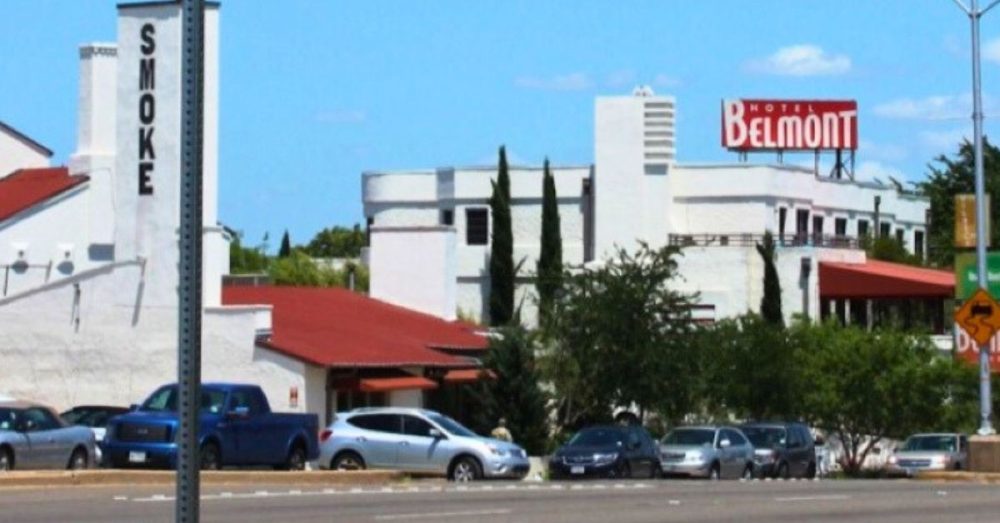Many people feel that they should be eligible for historic designation, as they have lived more of their lives than they have left to live.
Certain aspects endure as individuals move through life. Most hope to leave behind a meaningful legacy that will positively impact those who come after us and future generations.
Apart from leaving a legacy, inheritance includes more tangible assets such as bank accounts, homes, and vehicles.
Still, there is often more to what we cherish than what we can physically leave behind.
Community icons hold sentimental value, and as we age and these icons age, we appreciate seeing the value of both being recognized.
Such is the case with the 64-room Belmont Hotel at the corner of Fort Worth and Sylvan Avenues, slated for historic designation.
The original name of the hotel designed in 1947 was Belmont Motor Hotel, reported Candy’sDirt.
Over the years, the hotel has seen all sorts of action, some more flattering than others, including a few murders, a robbery, and a room fire. But let’s focus on the positive. After all, each of us has things we are not proud of in our past, right?
Here is more of what Candy’sDirt reported on the success story of Belmont, despite its ups and downs:
The Belmont Hotel is turning heads again. The 64-room hotel and bar at the corner of Fort Worth and Sylvan avenues was recently reinitiated for historic designation. While we await the new draft designation report and the next incarnation of this historic hotel, let’s look at the glory days in Belmont Hotel history.
Renowned Dallas architect Charles Dilbeck designed the Belmont Motor Hotel, as it was known in 1947. “The hotel with the sky-view of Dallas” was a truly cutting-edge concept and a popular destination for that first decade. A pool was added in 1950, a restaurant in 1953, and things were going extremely well.
Then, in 1957, the Dallas-Fort Worth Turnpike (I-30) opened. It diverted traffic and travelers from Fort Worth Avenue, and a downward spiral began. By 1965 the first good knights in shining armor came to the hotel’s rescue.
It was purchased by real estate broker J. DuVal West Sr. and his two sons. Quoted in the Dallas Morning News in June 1965, Mr. West Sr. said:
“I have always admired this property due to its architecture, excellent construction, central location, and its beautiful view overlooking downtown Dallas.”
Though neighborhood restaurant favorite the Hungry Bear was thriving next door, unfortunately, it was not long before the Belmont again spiraled downward. Newspaper archives through the decades are full of distressing stories about activities that took place at the once majestic destination.
- 1968 An attempted robbery at The Travelodge Motel resulted in the death of a motel clerk.
- 1973 The motel was under consideration for use as a minimum security jail.
- 1980 Methamphetamine dealer arrested
- 1979 The Hungry Bear went up for lease.
- 1983 Now known as the Travel Inn, a guest was murdered in their room.
- 1992 What was now known as the Travel Budget Motel had a room fire, causing $165,000 in damages.
- As you can see, the Belmont experienced about 30 years of steady decline, shady characters, and questionable activities. The Belmont needed another knight to save the day.
In 2004, Another Good Knight Saved the Belmont Hotel
That knight was Monte Anderson, a real estate developer known for his love of historic properties and sensitive redevelopment. Anderson had grown up looking up the hill to the Belmont and always found it intriguing.
“In the 1960s, my dad would take me to the Hungry Bear to eat, so the area holds a lot of memories for me,” Anderson said. “I drove by it almost every day over the years, and it struck me that someone might tear the hotel down. I didn’t want that to happen.”
On a trip to Austin in 2004 Anderson stayed at the Hotel San Jose. It was originally a 1936 motor court hotel that was renovated by Liz Lambert into a boutique hotel in 2000.
“I drove straight back to Dallas and up the hill, went in, and bought it right then,” Anderson said. “I did not really know what I was getting myself into. I thought, ‘I can do this. I can fix up old buildings. I did the Texas Theater, so no problem. How hard could it be?’”


